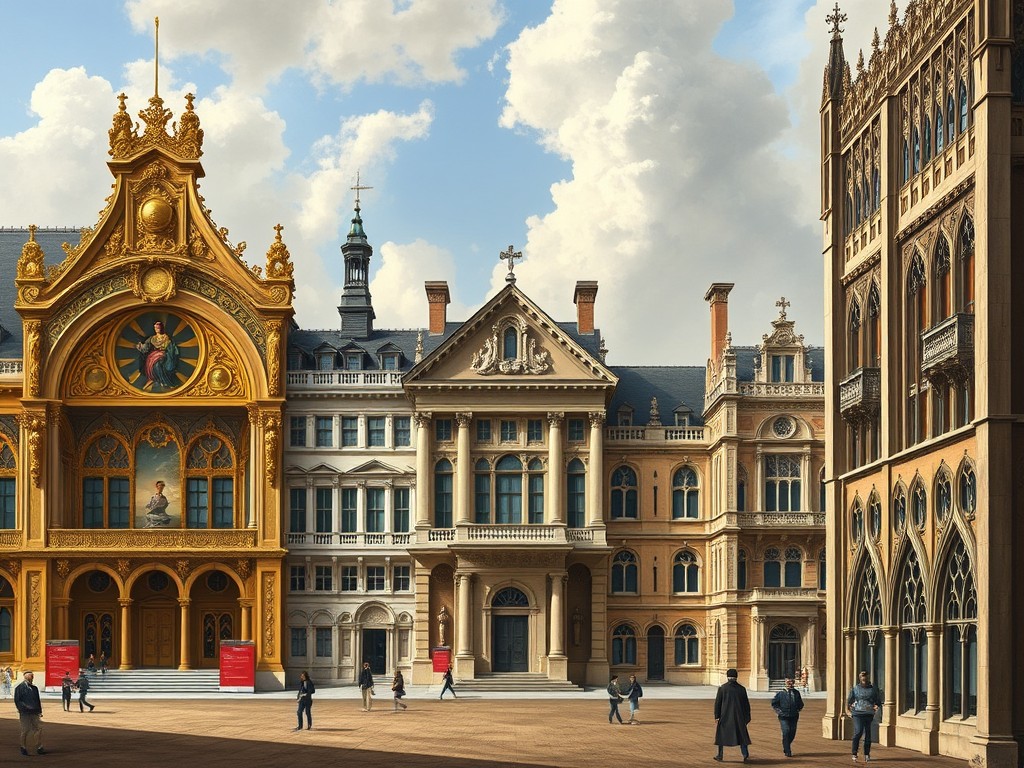How Did British Revival Architecture Change from the Rococo Style?
The Rococo style, originating in early 18th-century France, was an artistic and architectural movement characterized by its ornate, playful, and decorative elements. Known for its pastel colors, curvilinear forms, and intricate detailing, Rococo dominated European design for decades. However, as the 18th century progressed and tastes evolved, British architecture experienced a distinct transformation, moving away from the extravagance of Rococo toward revivalist styles that embraced classical and medieval influences. This article explores the shift in British architecture, tracing its development from the Rococo style to the various revival movements that defined the 19th century.
What Is Rococo Style, and How Did It Influence Early British Architecture?
The Rococo style, derived from the French term “rocaille” (meaning shellwork), emerged in France during the reign of Louis XV. This decorative style emphasized lightness, elegance, and exuberance, often employing asymmetrical motifs, gilded ornamentation, and intricate stuccowork. Rococo extended beyond architecture, influencing interior design, furniture, painting, and sculpture.
Although Rococo was primarily associated with continental Europe, its influence did reach British shores. In Britain, elements of Rococo appeared in country houses, palatial estates, and interior designs, often incorporated with a more restrained approach than in France. Architects and craftsmen like William Kent and Thomas Chippendale adopted Rococo motifs in furniture and interiors. However, Rococo’s impact in Britain was limited by its association with foreign opulence, which clashed with the country’s growing preference for structure and restraint.
The Decline of Rococo Style in Britain
By the mid-18th century, the Rococo style began to wane in Britain due to several cultural and societal shifts. The Enlightenment, with its emphasis on reason, order, and symmetry, fostered a renewed interest in classical antiquity. British architects and patrons increasingly favored the clean lines and balanced proportions of Palladianism and Neoclassicism over the whimsical excesses of Rococo.
Moreover, Britain’s growing sense of national identity distanced itself from the French-dominated Rococo aesthetic. Political tensions between Britain and France further diminished the appeal of the style, as British patrons sought architectural expressions that aligned with their cultural values and history.
Palladianism: The First Step Toward Revival Architecture
As Rococo faded, Palladianism emerged as a dominant architectural movement in Britain. Inspired by the works of Renaissance architect Andrea Palladio, Palladianism emphasized symmetry, proportion, and the use of classical elements such as columns, pediments, and domes. Architects such as Richard Boyle (the 3rd Earl of Burlington) and William Kent championed this style, designing buildings that reflected classical ideals of beauty and order.
Palladian architecture provided a stark contrast to Rococo’s ornate and irregular designs. Instead of playful ornamentation, Palladianism embraced simplicity and grandeur, influencing the construction of iconic British landmarks like Chiswick House and Holkham Hall. This movement laid the foundation for subsequent revivalist styles by reintroducing classical principles into British architecture.
The Rise of Gothic Revival: A Medieval Counterpoint to Rococo
While Palladianism and Neoclassicism emphasized classical antiquity, the Gothic Revival embraced medieval aesthetics. Beginning in the late 18th century and gaining momentum in the 19th, the Gothic Revival sought to revive the architectural styles of the Middle Ages, characterized by pointed arches, ribbed vaults, and intricate tracery.
This movement was partly driven by Romanticism, which idealized the past and celebrated the mysterious and picturesque qualities of medieval architecture. Architects such as Augustus Pugin and John Nash were instrumental in popularizing the Gothic Revival, designing churches, universities, and public buildings in the style. Iconic examples include the Palace of Westminster and St. Pancras Station in London.
The Gothic Revival’s focus on historical authenticity and moral virtue stood in stark opposition to the frivolity of Rococo. It reflected a broader cultural shift toward valuing heritage and tradition, aligning with Victorian ideals of piety and nationalism.
Neoclassicism: A Return to Order and Symmetry
While the Gothic Revival celebrated medieval architecture, Neoclassicism continued the classical tradition established by Palladianism. Inspired by the archaeological discoveries of ancient Greece and Rome, Neoclassicism emphasized geometric forms, symmetry, and restrained ornamentation.
Neoclassical architecture gained prominence in Britain during the late 18th and early 19th centuries, with architects like Robert Adam and Sir John Soane leading the movement. Buildings such as the British Museum and the Bank of England exemplify Neoclassical principles, featuring grand columns, domes, and harmonious proportions.
The transition from Rococo to Neoclassicism marked a clear rejection of frivolous decoration in favor of intellectual and cultural rigor. Neoclassicism’s emphasis on timelessness and universality resonated with the Enlightenment ideals that shaped British society during this period.
Victorian Eclecticism: The Synthesis of Revival Styles
The 19th century saw the emergence of Victorian eclecticism, a period in which architects combined elements from various revival styles to create unique and innovative designs. This eclectic approach reflected the era’s fascination with history and global influences, incorporating Gothic, Neoclassical, Romanesque, and even Oriental motifs.
Victorian architects such as Charles Barry and Alfred Waterhouse experimented with blending styles to suit the needs of modern institutions. For example, the Natural History Museum in London, designed by Waterhouse, combines Romanesque and Gothic elements to create a structure that is both functional and visually striking.
Victorian eclecticism underscored the adaptability of revival architecture, demonstrating how architects could reinterpret historical styles to meet contemporary demands. This flexibility marked a departure from the strict stylistic boundaries of Rococo and earlier movements.
Industrialization and the Functional Shift in Architecture
The Industrial Revolution brought profound changes to British architecture, challenging traditional notions of design and construction. Advances in engineering and materials, such as iron and steel, enabled the creation of large, complex structures that were previously unimaginable.
Functionalism began to emerge as a guiding principle in architecture, prioritizing utility and efficiency over decorative aesthetics. While Rococo had celebrated ornamentation for its own sake, industrial architecture embraced minimalist forms and innovative designs, as seen in structures like the Crystal Palace and railway stations.
The shift toward functionalism reflected the practical needs of an industrialized society, signaling the end of Rococo’s influence and the dawn of modern architecture.
The Enduring Legacy of Rococo in British Design
Although Rococo’s direct influence on British architecture was short-lived, its legacy can still be seen in certain decorative arts and interior designs. The style’s emphasis on craftsmanship and attention to detail inspired later movements, such as the Arts and Crafts movement, which sought to revive traditional artisan techniques.
Additionally, the playful and decorative aspects of Rococo occasionally reappeared in eclectic Victorian interiors and modern reinterpretations of historical styles. While British architecture ultimately moved in a different direction, Rococo remains an important chapter in the evolution of design.
Conclusion: From Rococo to Revivalism and Beyond
The transition from Rococo style to British revival architecture represents a fascinating journey through shifting cultural values, artistic ideals, and historical influences. While Rococo embodied the playful extravagance of 18th-century Europe, the revivalist movements that followed sought to reconnect with classical, medieval, and functional principles.
Palladianism, Gothic Revival, and Neoclassicism each played a pivotal role in shaping British architecture, reflecting the intellectual and social currents of their time. As industrialization and modernity took hold, these styles evolved further, paving the way for contemporary design.
Ultimately, the evolution of British architecture demonstrates the enduring power of historical styles to inspire innovation and adaptation. The Rococo style may have been a fleeting influence, but its impact on the decorative arts and the broader narrative of architectural history is undeniable.
Read Also Our This Post: Unveiling Louis Architectur Workspan: A Legacy of Iconic Designs

Kamran Khatri is a versatile writer and editor at ExpressZone.co.uk, bringing fresh perspectives and insightful commentary across a wide range of topics. With a passion for exploring diverse subjects—from technology, business, and finance to lifestyle, travel, and the arts—Kamran aims to inform, inspire, and engage readers through well-researched articles and thought-provoking content.
His work spans multiple categories including health, education, pets, entertainment, real estate, and sustainability, reflecting his commitment to delivering knowledge that connects with everyday life. Whether breaking down the latest trends, sharing practical tips, or highlighting cultural insights, Kamran’s writing combines clarity with creativity.
When he’s not crafting stories for ExpressZone.co.uk, Kamran enjoys keeping up with global developments, exploring innovative ideas, and connecting with readers who share his curiosity about the world.


